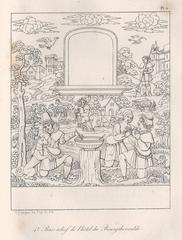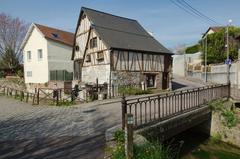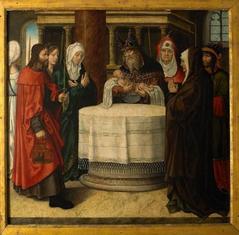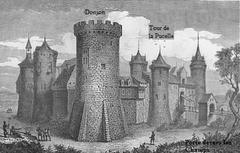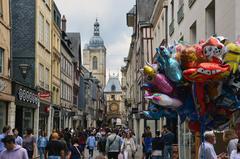
Quai Émile-Duchemin, Rouen, France: Visiting Hours, Tickets, and Historical Sites Guide
Date: 04/07/2025
Introduction
Quai Émile-Duchemin stands as one of Rouen’s most emblematic riverfront locations, offering visitors a captivating blend of maritime history, cultural landmarks, and vibrant urban life along the left bank of the Seine. Named after Émile Duchemin, a prominent figure in Rouen’s commercial development during the late 19th century, the quay reflects the city’s evolution from its Gallic origins, through Roman times, to its prominence as a medieval and industrial port (wikimonde.com).
Today, Quai Émile-Duchemin is not only a testament to Rouen’s rich past but also a vibrant cultural hub. Anchored by the Maritime, Fluvial and Harbour Museum of Rouen—housed in the historic Hangar 13—the quay immerses visitors in the city’s port heritage with exhibits of ship models, navigation instruments, and the notable barge Pompon Rouge (whichmuseum.co.uk). Beyond its historical significance, the quay serves as a lively space for leisure, annual events like the Foire Saint-Romain funfair, and world-renowned gatherings such as the Rouen Armada tall ships festival (wikimonde.com). Its integration into urban renewal projects ensures enhanced green spaces and improved accessibility for all (rouen.fr).
This comprehensive guide delivers essential information on visiting hours, ticketing, accessibility, and nearby attractions, alongside insights into the quay’s cultural and economic importance. Whether you are a history enthusiast, cultural explorer, or casual visitor, Quai Émile-Duchemin offers a memorable experience connecting Rouen’s past and present along the scenic Seine (petitfute.com).
Table of Contents
- Introduction
- Origins and Naming of Quai Émile-Duchemin
- Early Development and Port Expansion
- Industrial and Commercial Significance
- Architectural and Cultural Landmarks
- Visiting Quai Émile-Duchemin: Practical Information
- Transformations and Modern Usage
- Role in Rouen’s Urban and Economic Evolution
- Notable Historical Moments
- FAQ
- Visual and Interactive Elements
- Conclusion and Call to Action
Origins and Naming of Quai Émile-Duchemin
Named after Émile Duchemin, the influential president of Rouen’s Chamber of Commerce and Industry (1891–1897), Quai Émile-Duchemin honors those who shaped the city’s commercial and maritime landscape (wikimonde.com). Its position on the Seine’s left bank cements its status as a key part of the city’s historic port.
Early Development and Port Expansion
Rouen’s strategic location on the Seine fostered its transformation from a Gallic settlement to the Roman Rotomagus and, later, a major medieval trade center (lifeinruralfrance.com). The left bank, including Quai Émile-Duchemin, expanded in the 19th and 20th centuries to accommodate growing industrial commerce, with new warehouses and port facilities.
Industrial and Commercial Significance
By the 20th century, the quay became synonymous with Rouen’s industrial dynamism. It handled diverse cargo, including agricultural produce, wine, and bananas from the Antilles. In the 1930s, the vessel Petite Terre made Rouen a leading French banana import hub, representing 22% of national imports by 1938 (wikimonde.com). Hangar 13, built in 1926, was crucial for storage and logistics, initially for North African wines, later for fruit (en.wikipedia.org). The Schiaffino Company managed the warehouse until the 1970s, after which it shifted to other uses.
Architectural and Cultural Landmarks
The quay features several landmarks that celebrate Rouen’s maritime legacy:
- Maritime, Fluvial and Harbour Museum of Rouen: Opened in 1999 in Hangar 13, this museum offers interactive exhibits, ship models, navigation instruments, and the 38-meter barge Pompon Rouge (whichmuseum.co.uk).
- Château d’eau-marégraphe: This combined water tower and tide gauge highlights the quay’s logistical importance.
- Hangar 23: Formerly used by the Théâtre de l’Étincelle, this building exemplifies the adaptive reuse of industrial spaces (wikimonde.com).
Visiting Quai Émile-Duchemin: Practical Information
Visiting Hours
- Quai Émile-Duchemin: Publicly accessible year-round, 24/7.
- Maritime, Fluvial and Harbour Museum of Rouen:
- Open Tuesday to Sunday, 10:00 AM–6:00 PM
- Closed Mondays and certain holidays
Tickets
- Museum Admission:
- Adults: €7–€8
- Reduced rates for children, students, seniors
- Free for children under 12
- Purchase online or onsite (official museum website)
Accessibility
- Wheelchair accessible (ramps, elevators)
- Accessible restrooms
- Public transport: buses and trams nearby; limited parking adjacent to the quay
Nearby Attractions
- Rouen Old Town
- Rouen Cathedral
- Musée des Beaux-Arts
- Pont Flaubert: One of Europe’s tallest vertical-lift bridges
- Docks 76: Shopping and leisure complex in former warehouses
Events
- Foire Saint-Romain: November funfair with rides and food stalls (wikimonde.com)
- Rouen Armada: International tall ships festival (every four years, Normandie Tourisme)
Transformations and Modern Usage
With the decline of traditional port activities, Quai Émile-Duchemin has embraced a new role as a center for culture and recreation. The Maritime Museum preserves the quay’s industrial heritage while welcoming the public. The area is also home to the port de plaisance (marina) office and serves as a temporary terminal for cruise ships, reflecting Rouen’s growth in river tourism (petitfute.com).
Role in Rouen’s Urban and Economic Evolution
Quai Émile-Duchemin mirrors the city’s broader evolution from industrial port to a modern, heritage-focused urban center. Ongoing redevelopment projects are transforming the riverfront with improved public spaces, green areas, and sustainable urban design (rouen.fr).
Notable Historical Moments
- 1930s Banana Trade: Major hub for banana imports on the vessel Petite Terre (wikimonde.com)
- Construction of Hangar 13 (1926): Modernizing port infrastructure (en.wikipedia.org)
- Rouen Armada (1999): Inauguration of the Maritime Museum (whichmuseum.co.uk)
- Foire Saint-Romain: Annual funfair tradition (wikimonde.com)
Maritime, Fluvial and Harbour Museum: Exhibitions and Highlights
- History of the Port: Traces Rouen’s rise as a leading inland port.
- Merchant Navy & River Navigation: Explores shipping, river trade, and the Seine’s economic role.
- Whaling & Polar Expeditions: Features Jean-Baptiste Charcot’s explorations.
- Shipbuilding & Floating Docks: Showcases models, archival photos, and interpretive panels.
- Pompon Rouge: Step aboard this barge to learn about river transport life.
Interactive workshops, guided tours (in French and English), and educational activities for families and school groups are available.
Visitor Facilities and Accessibility
- Restrooms and Water Points: Available along the quay and at event sites.
- Accessibility: Ramps, accessible toilets, and support services, including Braille and large-print documents, Easy-to-Read materials, and sign language tours.
- Transport:
- TEOR Bus Lines 1, 2, 3 (stop: Mont-Riboudet)
- Tram Line T2 (stop: Gare-Rive-Droite)
- Parking: Public lots at Docks 76 and city center; park-and-ride options
Special Events and Seasonal Highlights
- Rouen Armada: Tall ships festival, parades, concerts, and fireworks (Normandie Tourisme)
- Foire Saint-Romain: France’s oldest funfair, with rides and regional food (wikimonde.com)
- Temporary Exhibitions: Rotating maritime and industrial heritage displays at the museum
Photographic Spots and Visual Highlights
- Views of the Seine: Ideal for panoramic photos—especially at sunset or during festivals.
- Hangar 13 and Historic Warehouses: Industrial architecture contrasts with modern developments.
- Event Scenes: Document vibrant community life during Armada and Foire Saint-Romain.
Suggested alt text for images:
“Quai Émile-Duchemin visiting hours”, “Maritime Museum Rouen tickets”, “Rouen historical sites”
Frequently Asked Questions (FAQ)
Q: What are the visiting hours for the quay and Maritime Museum?
A: The quay is open year-round. The museum is open Tuesday–Sunday, 10:00 AM–6:00 PM.
Q: Is there an entry fee?
A: Access to the quay is free. Museum tickets cost €7–€8; reductions available.
Q: Is the site accessible for visitors with reduced mobility?
A: Yes, both the quay and museum are accessible.
Q: Are guided tours offered?
A: Yes, in French and English. Book in advance for groups.
Q: How do I get there by public transport?
A: Use TEOR bus lines 1–3 (Mont-Riboudet stop) or Tram T2 (Gare-Rive-Droite stop).
Q: Where can I park?
A: Public parking is available at Docks 76 and along the quays.
Practical Tips for Visitors
- Best visiting periods: Spring and summer for pleasant weather and events.
- Duration: 1.5–2 hours for museum and promenade.
- Food: Cafés and restaurants at Docks 76 and nearby neighborhoods.
- Cashless payments: Many sites accept cards and mobile payments.
- Download official event apps for live updates and maps.
- Public transport: Free on Saturdays on the Astuce network.
Conclusion and Call to Action
Quai Émile-Duchemin encapsulates the essence of Rouen’s maritime heritage and its transformation into a vibrant cultural and economic hub. From its historical importance as a commercial port—marked by milestones like the 1930s banana trade—to its current role as a destination for heritage, tourism, and major events, the quay offers a rich, multidimensional visitor experience (wikimonde.com).
The Maritime, Fluvial and Harbour Museum provides an engaging journey into Rouen’s port history, while the quay itself invites leisurely walks with picturesque Seine views and proximity to other landmarks like Rouen Cathedral and the Old Town (whichmuseum.co.uk). Annual events such as the Foire Saint-Romain and Rouen Armada animate the area and foster community spirit (rouen.fr). With excellent accessibility measures and comprehensive public transport links, the quay welcomes all visitors.
For up-to-date information on visiting hours, ticket prices, and guided tours, consult the official museum website. Enhance your visit by downloading the Audiala mobile app for audio guides and real-time updates. Follow local social media channels for the latest on exhibitions and events. Don’t miss the opportunity to experience Rouen’s rich maritime legacy and dynamic present at this iconic riverside destination (petitfute.com).
References
- Quai Émile-Duchemin, 2025, Wikimonde (wikimonde.com)
- Maritime, Fluvial and Harbour Museum of Rouen, 2025, WhichMuseum (whichmuseum.co.uk)
- History of Rouen, 2025, Life in Rural France (lifeinruralfrance.com)
- Maritime Museum of Rouen, 2025, Petit Futé (petitfute.com)
- Rouen Urban Renewal Projects, 2025, Rouen.fr (rouen.fr)

